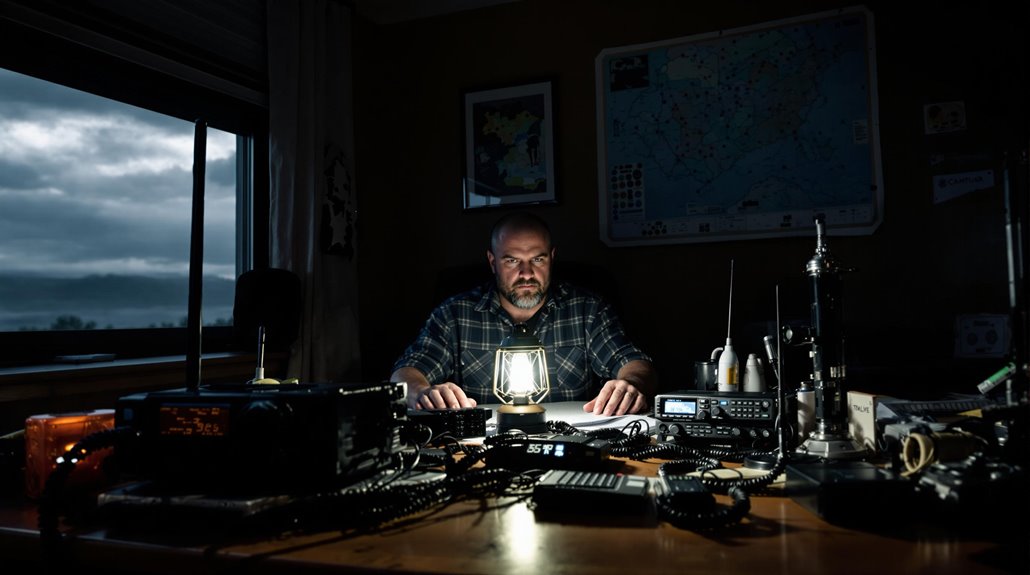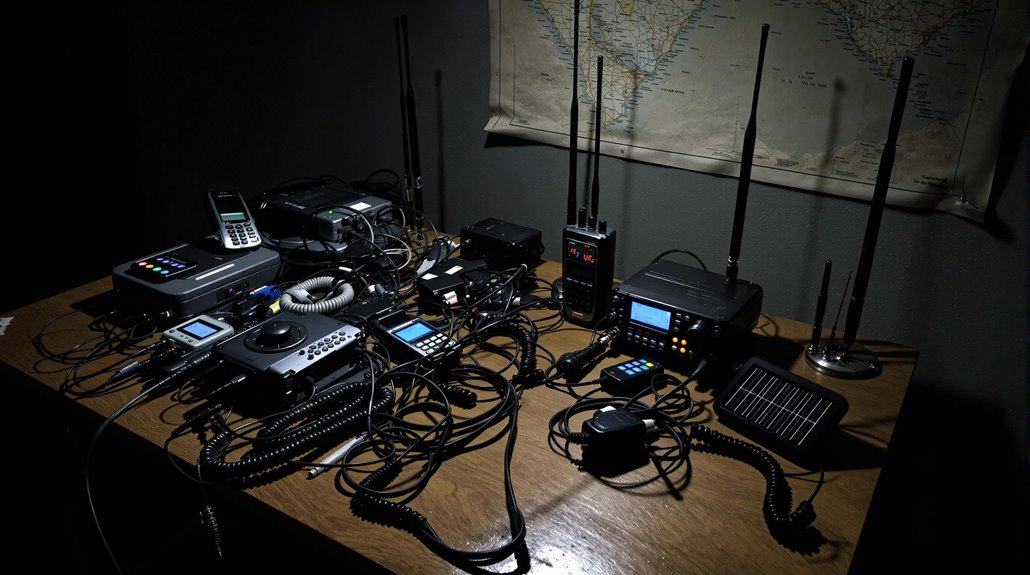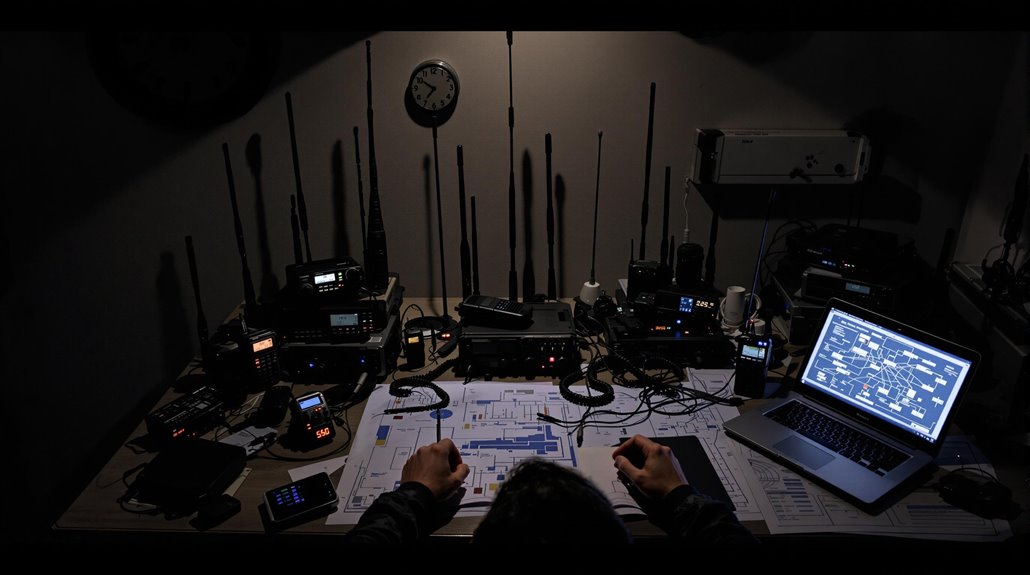Why Every Prepper Needs a Backup Communication Plan

In disasters, cell phones can fail due to weather or power outages, leaving you stranded without communication. As a prepper, having a backup plan is essential. You should investigate methods like amateur or two-way radios, which remain functional when cell networks are down. Satellite phones provide global coverage, bypassing ground-based failures. Equip yourself with emergency radios for real-time alerts and backup power to keep devices running. Following the PACE approach—primary, alternate, contingency, emergency—ensures you're prepared. Regular practice sharpens your skills, so when challenges arise, you're ready. Discover more about making your communication strategy foolproof.
Identifying Communication Challenges
In the domain of preparedness, understanding communication challenges is vital. Cell phones are a staple in our daily lives, yet they're highly vulnerable during disasters. Severe weather, power outages, and even targeted attacks can cripple communication equipment, leaving you without a lifeline. Historically, disruptions in cell tower operations have shown how quickly our primary communication methods can falter. That's why a robust emergency plan is critical. A well-structured PACE communication plan is your key to maintaining contact when traditional systems fail. Regularly updating and practicing this plan with your family is significant. It guarantees everyone is familiar with backup options, like ham radios, which can operate on different radio frequencies, providing a reliable alternative when cell networks are down. Having a plan for seasonal preparedness can help mitigate communication challenges during specific weather-related power outages.
Exploring Communication Methods
With the challenges of modern communication systems in mind, let's look at diverse methods to stay connected when they fail. Cell phones are often the primary line of communication, but during natural disasters, networks can collapse. That's when backup methods become fundamental. Amateur radio is a popular choice for emergency communication, offering reliable connections when other systems falter. They operate independently of cell networks, ensuring you can reach out when it matters most. Two-way radios, such as FRS and GMRS, are excellent for short-distance communication without reliance on cell towers. They're ideal for coordinating with family or a group nearby. NOAA weather radios provide critical alerts and information, even during power outages, keeping you informed about public safety issues. Remember, a reliable power source is essential to keep these devices operational. Satellite phones offer another robust alternative, bypassing ground-based infrastructure entirely, making them invaluable during widespread network failures. Electromagnetic pulses and direct attacks can disrupt GPS signals, highlighting the importance of having diverse communication tools readily available. Implementing the P.A.C.E. principle—Primary, Alternate, Contingency, Emergency—ensures you have layered communication methods ready. Don't forget to maintain written contact lists and memorize key numbers, enhancing your preparedness. Diversifying your communication methods is crucial for staying connected when conventional systems fail.
Essential Communication Gear

When planning for emergencies, having vital communication gear is imperative for staying connected and informed. Start by equipping yourself with emergency radios like NOAA weather radios and ham radios. These provide reliable information and long-distance communication during crises, guaranteeing you stay updated on any developments. Ham radios, in particular, are invaluable for their ability to communicate across vast distances, even when other systems fail.
Backup power solutions are also important. Consider options like Jackery solar generators to keep your communication devices operational during extended power outages. These solutions guarantee your radios and other electronic gear remain charged and ready to use.
Two-way radios, such as walkie-talkies and Family Radio Service (FRS) devices, offer immediate short-distance communication that doesn't rely on cellular networks. They're perfect for quick exchanges with family members in the vicinity.
For more remote situations, satellite phones are a dependable choice. They provide voice and text communication independently of terrestrial systems, which is significant if infrastructure is compromised.
Finally, practice using all your radio gear regularly. Familiarity with these devices and protocols guarantees that you and your family members can effectively communicate when it matters most, enhancing your complete preparedness. Including emergency alert systems can further ensure that you receive timely warnings and crucial updates during any emergency scenario.
Crafting a Reliable Plan
Crafting a reliable backup communication plan means you've got to investigate the P.A.C.E. principle, which stands for Primary, Alternate, Contingency, and Emergency methods. Start by defining your primary mode of communication, likely your cell phone. Don't forget, though, that in a case of emergency, cell service might be down. That's where alternate methods come in, like using satellite phones or radio equipment.
For contingency, consider getting a HAM license. This lets you work without relying on traditional services, using Amateur radio to communicate. The Preppers Guide emphasizes the importance of having HAM radios as they provide a robust alternative when usual systems fail. It is also beneficial to incorporate reliable communication devices such as two-way radios or tactical flashlights into your plan to ensure you remain connected during emergencies.
For emergency methods, include family band radios, which are accessible and don't require a license. Confirm you maintain a written contact list, guaranteeing you can reach your trusted contacts even when digital storage isn't an option.
Share designated meeting points with family and friends, so everyone knows where to regroup if communication is compromised. This layered approach guarantees you're prepared for any breakdown in communication, enhancing your safety and readiness for whatever comes your way.
Practicing and Testing Systems

Having laid out a solid backup communication plan, it's time to focus on practicing and testing these systems. Start by scheduling regular practice sessions using diverse communication methods, such as radios and messaging apps. This improves familiarity and guarantees all family members understand the protocols and equipment. Make certain everyone knows how to operate devices efficiently and can communicate effectively during an emergency.
Conduct drills that simulate emergency scenarios. These drills allow you to test the effectiveness of your backup communication plans and spot any potential issues beforehand. Utilize community amateur radio nets for practice. Not only does this help hone your communication skills, but it also builds connections with others who might assist during real emergencies. When conducting these drills, ensure that battery operated lights are included in your emergency kit to maintain a secure and well-lit environment.
Testing your communication systems periodically is essential. Check that all devices are functional, properly charged, and ready for use when needed. Pay special attention to verifying battery life and backup power sources. Keeping a log of successful communications during practice sessions can help assess the reliability of different methods. This information is critical for refining your comprehensive communication strategy for emergencies, guaranteeing your family is prepared and connected when it matters most.




